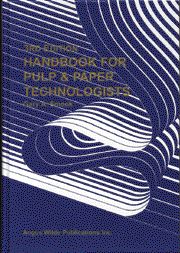
Features
Research & Innovation
Handbook for Pulp and Paper Technologists, by Gary A. Smook
This is the third edition of a well known and respected textbook; the second edition was published in 1992. Treatment is in the form of a detailed overview, rather than an in-depth examination. The au...
February 1, 2003 By Pulp & Paper Canada

This is the third edition of a well known and respected textbook; the second edition was published in 1992. Treatment is in the form of a detailed overview, rather than an in-depth examination. The author is to be complimented on his broad appreciation of the technology and his ability to extract and summarize the essentials in a logical and easy-to-read style. Chapter headings are identical to previous editions.
The subject matter covers the manufacturing technology of pulp and paper, starting with the chemical and morphological characteristics of wood and fibres, wood preparation, pulping, pulp processing, chemical recovery, bleaching and brightening. An overview chapter on pulping methodology prepares the reader for more detailed upcoming information and provides an introduction to organosolv and biopulping. Papermaking operations start with stock preparation, including the use of recycled fibre and non-fibrous additives. The paper machine is covered from the headbox to the winder. Sizing, coating and supercalendering of paper are discussed in a separate chapter.
Beyond the basic technology, several chapters are included to provide a broader context. These include mill operating strategies and economics, manufacture of specific paper and board grades, properties and testing of pulp and paper, and paper end uses. Excellent introductions to process control and essential mill services such as boiler operations and electrical distribution are also provided.
The basics of water and air pollution control are covered. This is particularly useful knowledge for the technology program graduate seeking employment in a mill, as the entry level positions tend to be in the laboratory, with particular responsibilities for pollution abatement systems.
Text is supported by almost 700 illustrations and photographs. Previous editions have likewise been prolifically illustrated to the benefit of the reader. It is gratifying that this feature has been maintained and, indeed, expanded in some chapters.
In a handbook covering basic technology, one would not expect a complete revision. The author has supplemented or modified chapters where appropriate. Statistical data on such items as production rates and machine speeds have been updated.
Because chlorine bleaching is being phased out in North American mills, the author has given special attention to the chapter on bleaching. The list of sequences has been expanded to include recent developments such as peracetic acid and enzymes. The concepts of elemental chlorine free (ECF) bleaching, totally chlorine free (TCF) bleaching and totally effluent free (TEF) operation are introduced.
This book has been the required reference for students in the Pulp and Paper Program at BCIT, and with good reason as each edition has provided the breadth and depth of information appropriate to this post-secondary level. The fact that the book is also used in mill training programs and specified by private training organizations attests to its broad application.
The third edition maintains the high standard of the previous editions and, in my opinion, ensures that the “Smook Book” will continue to serve both institutions and industry well into the future.
Alan Wilkes is an instructor in pulp and paper technology, Chemical Sciences Program, British Columbia Institute of Technology, Burnaby, BC.
Print this page